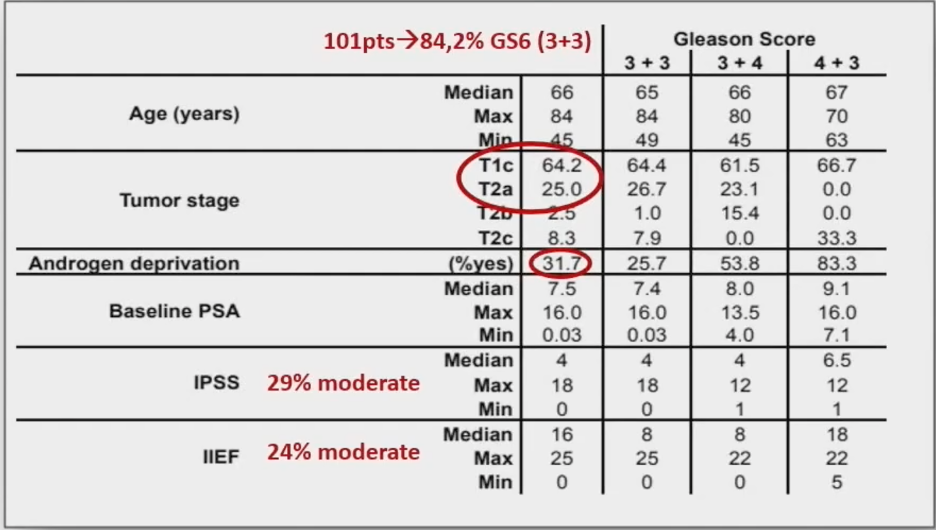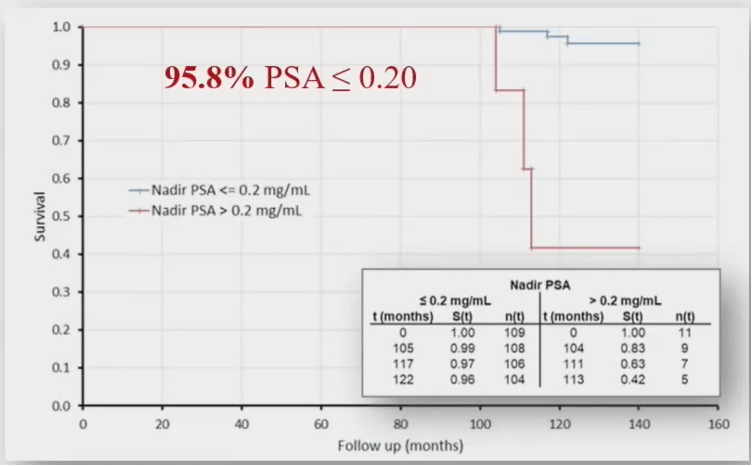held in San Diego, CA between October 1st and 4th, 2023 was host to a session on miscellaneous genitourinary topics. Dr. Elena Moreno-Olmedo presented the long-term outcomes of a prospective clinical trial evaluating ultra-hypofractionated high-dose rate (HDR) brachytherapy monotherapy administered twice in a single day in patients with localized prostate cancer.
In 2018, a prospective trial of 120 patients with low- (n=84) or intermediate-risk (n=36) prostate cancer evaluated the efficacy and safety of HDR brachytherapy administered twice daily in 13.5 Gy fractions between November 2010 and February 2016. The treatment was administered twice daily in 6-hour interfraction intervals using a single implant, with a total dose of 27 Gy. All patients had a prostatic volume of 12 – 80 cc (determined per MRI) and an IPSS of <15. Of note, short-term ADT of 6 months duration was allowed.

This regimen was associated with excellent efficacy outcomes at a median follow-up of 4.4 years:
- Biochemical failure-free survival: 96%
- Metastasis-free survival: 98%
- Overall survival: 98%
Furthermore, the cumulative incidence of acute grade 2 and 3 genitourinary (GU) toxicity was only 9% and 2%, respectively, and that of late GU toxicity were 18% and 1%, respectively. No grade ≥4 toxicity was detected. No acute gastrointestinal toxicities were recorded, and only 1 patient had grade 2 rectal bleeding. 24% of patients not receiving ADT had Grade 1-2 sexual dysfunction.1
As such, the objective of this updated analysis was to report the long-term, 10-year outcomes of this trial. The median patient age was 66 years (range 45-84) and median PSA was 7.5 ng/ml (range 0.01-16 ng/ml). Overall, 84% had Gleason score 6 and 16% Gleason 7. Thirty-one percent of patients received ADT.
At a median follow-up of 123 months, the actuarial rates for the oncologic outcomes were as follows:
- No biochemical evidence of disease (bNED), using the Phoenix criteria: 93.3%
- Local control: 95.2%
- Metastasis-free survival: 96.1%

The median time to a PSA nadir was 80.5 months. Patients who achieved a PSA nadir ≤ 0.20 ng/mL exhibited a 10-year bNED survival rate of 97%, whereas those who failed to reach this PSA level had a survival rate of only 40%.2

Based on these results, Dr. Moreno-Olmedo concluded her presentation with the following take home messages:
- Ultra-hypofractionated HDR brachytherapy administered in 2 single day doses for patients with localized prostate cancer using an immobilization system is safe with a favorable toxicity profile and appears to be highly curative with a 10-year bNED of 93.3% with a local control rate of 95%.
- 96% of alive patients achieve a PSA nadir of ≤ 0.20 ng/ml and based on the subsequent overall survival outcomes and this appears to be a prognostic factor.
Presented by: Elena Moreno-Olmedo, MD, MSc, Clinical Research Fellow at Genesiscare and University of Oxford, Oxford, UK
Written By: Rashid K. Sayyid, MD, MSc – Society of Urologic Oncology (SUO) Clinical Fellow at The University of Toronto, @rksayyid on Twitter during the 2023 American Society for Therapeutic Radiation Oncology (ASTRO) 65th Annual Meeting held in San Diego, CA between October 1st and 4th, 2023
References:- Nagore G, Guerra JLL, Krumina E, et al. High dose rate brachytherapy for prostate cancer: A prospective toxicity evaluation of a one day schedule including two 13.5 Gy fractions. Radiother Oncol. 2018;127(2):219-24.
- Nagore G, Moreno-Olmedo E, Suarez-Gironzini V, et al. Long-term outcomes of ultra-hypofractionated 2 fractions single day HDR brachytherapy in localized prostate cancer. Radiother Oncol. 2023;186:109807.


